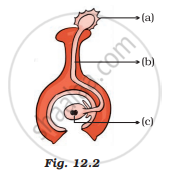Advertisements
Advertisements
Question
Find an odd one out.
Options
Budding
Regeneration
Binary fission
Fragmentation
Solution
Binary fission
APPEARS IN
RELATED QUESTIONS
What is multiple fission?
Identify the figures showing the process of budding in yeast.

(A) I, II and III
(B) II, III and IV
(C) I, II and IV
(D) III, IV and I
Define asexual reproduction.
What happens when On maturation sporangia of Rhizopus bursts?
Name the asexual method of reproduction in Plasmodium.
Explain why, more complex multicellular organisms cannot give rise to new organisms through regeneration.
Name one commonly used vegetable which is propagated by using tubers.
Name one unicellular organism which reproduces by the same asexual process as Hydra.
Define 'stock' and 'scion'.
A simple multicellular animal having tentacles which lives in freshwater usually reproduces by the asexual process of :
(a) binary fission
(b) spore formation
(c) budding
(d) fragmentation
One of the following organisms does not reproduce by fission. This is :
(a) Amoeba
(b) Leishmania
(c) Planaria
(d) Plasmodium
The thread like structures that develop on a moist slice of bread in Rhizopus are ______.
Vegetative propagation refers to the formation of new plants from the following existing organs of the old plants :
(a) stems, roots and flowers
(b) stems, roots and leaves
(c) stems, flowers and fruits
(d) stems, leaves and flowers
Why is it disadvantageous to grow plants vegetatively?
Multiple choice question. Tick (✓) the correct choice:
The common method of reproduction in bacteria is
- budding
- fragmentation
- binary fission
- all the above
Fill in the blank:
Budding is a kind of _________ reproduction.
Define the following:
Budding
Describe the advantages of vegetative reproduction.
What happens when a mature spirogyra filament attains considerable length?
List two advantages of vegetative reproduction practiced in case of an orange plant.
What is fragmentation in organisms?
Complete the following chart:
| Asexual reproduction | Sexual reproduction | ||
| 1. | Reproduction that occurs with the help of somatic cells is called as asexual reproduction. | 1. | ____________ |
| 2. | ____________ | 2. | Male and female parent are necessary for sexual reproduction. |
| 3. | This reproduction occurs with the help of mitosis only. | 3. | ____________ |
| 4 | ____________ | 4. | New individual formed by this method is genetically different from parents. |
| 5 | Asexual reproduction occurs in different individuals by various methods like binary fission, multiple fission, budding, fragmentation, regeneration, vegetative propagation, spore production, etc. | 5. | ____________ |
Name two flowering plants that reproduce both by seeds and by vegetative means.
Define.
Vegetative propagation
Name the three types of asexual reproduction in unicellular organisms.
Distinguish between the following.
Binary fission and Multiple fission
Observe the given picture and answer the questions given below.

- State the type of reproduction.
- Identify the part of reproduction.
Sweet potato - _____________
Bryophyllum - _____________
Potato - _____________
- Which type of reproduction is indicated in the following diagram?
- Redraw the given type of reproduction in the correct sequence and explain it.

By which of the following egg in female gametophyte is accompanied?
The ability of a cell to divide into several cells during reproduction in Plasmodium is called ______
Characters that are transmitted from parents to offspring during reproduction show
In Rhizopus, tubular thread-like structures bearing sporangia at their tips are called
In Figure, the parts A, B and C are sequentially

Which of the following statements is/are true for sexual reproduction in plants?
(i) Plants are obtained from seeds.
(ii) Two plants are always essential.
(iii) Fertilisation can occur only after pollination.
(iv) Only insects are agents of pollination.
Choose from the options given below.
In the diagram given in Figure 12.2 label the parts marked (a), (b) and (c).

When you keep food items like bread and fruits outside for a long time, especially during the rainy season, you will observe a cottony growth on them.
What is this growth called?
In an asexually reproducing species, if a trait X exists in 5% of a population and trait Y exists in 70% of the same population, which of the two trait is likely to have arisen earlier? Give reason.
The "Eyes" of the potato tuber are ______.
What is Regeneration?
